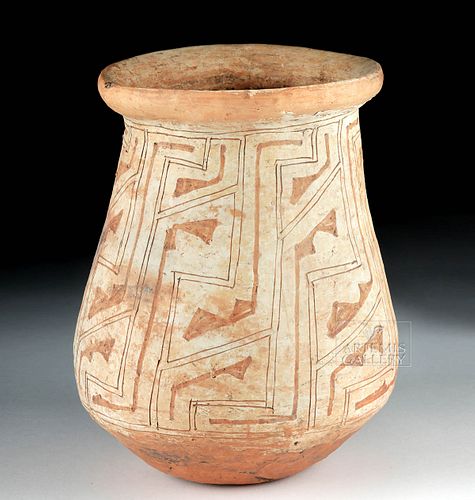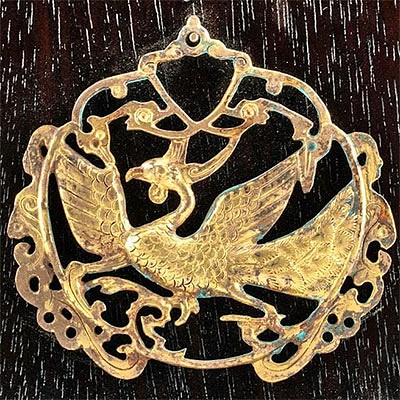Marajoara Cream-Slipped Olla w/ Geometric Motifs
Lot 229
About Seller
Artemis Fine Arts
686 S Taylor Ave, Ste 106
Louisville, CO 80027
United States
Selling antiquities, ancient and ethnographic art online since 1993, Artemis Gallery specializes in Classical Antiquities (Egyptian, Greek, Roman, Near Eastern), Asian, Pre-Columbian, African / Tribal / Oceanographic art. Our extensive inventory includes pottery, stone, metal, wood, glass and textil...Read more
Categories
Estimate:
$2,400 - $3,600
Absentee vs Live bid
Two ways to bid:
- Leave a max absentee bid and the platform will bid on your behalf up to your maximum bid during the live auction.
- Bid live during the auction and your bids will be submitted real-time to the auctioneer.
Bid Increments
| Price | Bid Increment |
|---|---|
| $0 | $25 |
| $300 | $50 |
| $1,000 | $100 |
| $2,000 | $250 |
| $5,000 | $500 |
| $10,000 | $1,000 |
| $20,000 | $2,500 |
| $50,000 | $5,000 |
| $100,000 | $10,000 |
| $200,000 | $20,000 |
About Auction
By Artemis Fine Arts
Jun 17, 2021
Set Reminder
2021-06-17 10:00:00
2021-06-17 10:00:00
America/New_York
Bidsquare
Bidsquare : Ancient & Ethnographic Art Through The Ages
https://www.bidsquare.com/auctions/artemis-gallery/ancient-ethnographic-art-through-the-ages-7094
Ancient art from Egypt, Greece, Italy and the Near East, as well as Asian, Fossils, Pre-Columbian, Native American, African / Tribal / Oceanic, Fine art, and much more! All categories, all price ranges... all legally acquired and guaranteed to be as described or your money back. Artemis Fine Arts info@artemisfinearts.com
Ancient art from Egypt, Greece, Italy and the Near East, as well as Asian, Fossils, Pre-Columbian, Native American, African / Tribal / Oceanic, Fine art, and much more! All categories, all price ranges... all legally acquired and guaranteed to be as described or your money back. Artemis Fine Arts info@artemisfinearts.com
- Lot Description
Pre-Columbian, Brazil, Lower Amazon Basin, Marajo Island, Marajoara culture, ca. 800 to 1400 CE. A beautiful hand-built vase with a planar base, a wide body which gradually tapers inwards, a thick everted rim, and a deep interior cavity. The body is adorned with a dense decorative register of abstract incised geometric motifs, and a contiguous set of incised parallel border lines encloses each shape. The areas surrounding the geometric embellishments are colored with a chalky-white pigment which imbues the vessel with an elegant, uncomplicated bi-chrome presentation. Funerary urns like this example were used to hold the remains of a deceased individual, acting as an informal coffin for burial. Size: 7.5" W x 9.625" H (19 cm x 24.4 cm).
The Marajoara – also known as the Marajo – flourished on Marajo Island in the mouths of the Amazon and Tocantins River in Brazil. They built impressive mounds – ranging from 3 to 10 meters in height - and lived subsistence lifestyles. This was a large-scale civilization, contrary to what many European researchers believed of the Amazon before their discovery, as some sites cover more than 10 square kilometers and contain 20 to 30 individual mounds.
The Marajoara thrived on their island while producing what is generally regarded as the oldest ceramic artform in Brazil – indeed among the oldest forms in the Americas – with numerous decorative traditions and techniques which developed over time. Beginning with the Ananatubas, the oldest potters of the island dating from the 1st millennium BCE, several unique ceramic traditions emerged; however, what is known as the Marajoara polychrome phase existed from about 400 to 1350 CE. Though they developed approximately fifteen different finishing techniques, one of the more stylish and interesting finishes combines red and white wash, incised detailing, excision, and painting in assorted designs similar to this example. Urns like this were buried in the many large cemeteries known from the region, and the soil conditions have preserved the human remains inside them quite well; as of yet, no formal studies have been undertaken on them, representing a potential treasure trove of information that could rewrite what we think of the ancient Amazon Basin.
For a similar example, please see Young-Sanchez, Margaret and Denise Pahl Schaan. Marajo: Ancient Ceramics from the Mouth of the Amazon. Mayer Center for Pre-Columbian & Spanish Colonial Art at the Denver Art Museum, 2011, p. 36, fig. 24.
Provenance: private Hawaii, USA collection; ex-Eugene Lions collection, Geneve, Switzerland, 1960 to 2000
All items legal to buy/sell under U.S. Statute covering cultural patrimony Code 2600, CHAPTER 14, and are guaranteed to be as described or your money back.
A Certificate of Authenticity will accompany all winning bids.
We ship worldwide and handle all shipping in-house for your convenience.
#133776Vessel repaired from several large pieces with some resurfacing, overpainting, and light adhesive residue along break lines. Surface wear and abrasions commensurate with age and use, small nicks to rim, body, and base, fading to some finer incised decorations, and fading to areas of pigmentation. Light earthen and mineral deposits throughout. Old inventory number in black ink as well as an old inventory sticker on base.Condition
- Shipping Info
-
All shipping is handled in-house for your convenience. Your invoice from Artemis Gallery will include shipping calculation instructions. If in doubt, please inquire BEFORE bidding for estimated shipping costs for individual items.
-
- Buyer's Premium



 EUR
EUR CAD
CAD AUD
AUD GBP
GBP MXN
MXN HKD
HKD CNY
CNY MYR
MYR SEK
SEK SGD
SGD CHF
CHF THB
THB
















